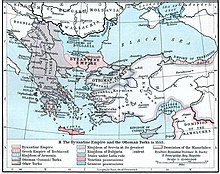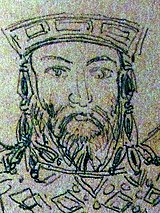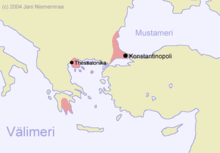Byzantine Civil War (1373-1381)
The Byzantine Civil War from 1373 to 1381 was a series of conflicts over supremacy in the Byzantine Empire between Emperor John V Palaiologos and his eldest son Andronikos IV.
prehistory
After gaining sole rule in 1354, John V pursued a decidedly pro-Western foreign policy, while the Ottomans first gained a foothold on European soil in Thrace . In search of allies, he visited Pope Urban V in 1369 , converted to Catholicism and then traveled to Venice for negotiations . During his absence, his two eldest sons, the co-emperor Andronikos IV and the despot Manuel , acted as regents in Constantinople and Thessaloniki . When Andronikos IV refused to financially enable his father to return from Venice and to hand over the island of Tenedos to the Venetians in accordance with the contract , he was imprisoned by them and only released two years later on the intervention of Manuel.
1373: First conflict

When John V became dependent on the increasingly stronger Ottoman Empire under Sultan Murad I in 1373 and fought alongside him in Anatolia , Andronikos rebelled against his father. For this he allied himself with Murad's son Savcı Bey , who in turn had started an uprising against the Ottoman ruler. It is possible that he represented a political faction that opposed his father's rapprochement with the papacy. Another reason for the uprising may have been that Johannes increasingly turned to Manuel and Andronikos feared for his succession to the throne.
On May 6, Andronikos left the capital and united his forces with those of the Turkish insurgent. But his uprising was put down by the end of the month, that of Savcı Bey in September. Murad blinded his son and finally even killed him and asked Johannes to do the same with his son and his child and co-emperor Johannes . But only one eye was blinded out of gratitude from their father (according to another version, the two only partially regained their eyesight later). They were taken to a prison in the northwest of the city, the Tower of Anemas . Instead of Andronikos, his brother Manuel was installed as heir of the father on September 25th and was crowned co-emperor. In 1375 a delegation under Philipp Tzykandyles was sent to the Pope to justify the blinding in front of him.
1376: Second conflict
In July 1376 the Genoese helped Andronikos IV to escape from prison and took him to their Galata district . With the support of his liberators and the Turks (who provided a mixed army of horsemen and foot soldiers and who, in turn , hired the Serbian King Marko Kraljević to help), he began a siege of Constantinople, which was taken on August 12th after a month. The rest of the imperial family holed up in the Golden Gate for a few days before they too gave up. Now Andronikos IV finally took over power and brought his father and his brothers Manuel and Theodor to the Tower of Anemas. The patriarch Philotheos Kokkinos , who refused to crown the usurper, was deposed; Makarios took his place . On October 18, 1377 this Andronikos crowned the sole ruler and his son John VII as co-emperor.
1379: Third conflict
In the summer of 1379 John V was able to flee (allegedly through the use of his wife Helena or with the help of Venetian agents) and went to the Ottoman field camp in Chrysopolis . He succeeded in outbidding the tribute of his son to Murad (allegedly 30,000 gold coins annually) and in leaving Philadelphia, the last Byzantine base in Asia Minor, to the Turks . In doing so he brought the Sultan to his side. With his support and with the help of Venice's fleet, Byzantium was attacked at the end of June. With the exception of a Genoese garrison, the defense was very half-hearted and after taking Constantinople, Andronikos was overthrown on July 1st. John V was brought back to power by his allies. Allegedly Murad I had given the townspeople the choice of either recognizing himself or John as ruler. The patriarch Makarios installed by Andronikos lost his office again.
consequences
Andronikos IV. Himself withdrew after his recent defeat in the Genoese district of Pera and took his mother Helena, his aunts Maria and Theodora and their father John VI. as hostages with you. In the years that followed, the Galata peninsula (on which Pera is also located) was besieged by his father's party and his Ottoman and Venetian allies in conditions similar to civil war. Only when Andronikos' right to the succession to the throne was formally recognized again in a phase of relaxation in May 1381 did he release the prisoners. Andronikos received Selymbria and some other places on the Marmara Sea as a dominion.
swell
- Laonikos Chalkokondyles 1, 34–78 passim (ed. Eugen Darkó, 1927)
- Chronica Byzantina breviora 181-183 and passim (ed. Peter Schreiner , CFHB Ser. Vind. Vol. 12/1, 1975)
- Chronikon peri tōn Tourkōn soultanōn 25–36 passim (ed. Georgios Theodorou Zoras , 1958)
- Dukas 69–73 (ed. Vasile Grecu, 1958)
- Demetrios Kydones , Letters 2, 23 (ed.Raymond -Joseph Loenertz , 1960)
literature
- Mark C. Bartusis: The Late Byzantine Army: Arms and Society 1204-1453. University of Pennsylvania Press, Philadelphia PA 1997, ISBN 0-8122-1620-2 .
- Hans-Georg Beck : History of the Orthodox Church in the Byzantine Empire. A manual (= The Church in Her History . Vol. 1, Lfg. D 1). Vandenhoeck & Ruprecht, Göttingen 1980, ISBN 3-525-52312-2 .
- Franz Dölger : On the uprising of Andronikos IV against his father Johannes V in May 1373 . In: Revue des études byzantines. Vol. 19, 1961, ISSN 0766-5598 , pp. 328-332.
- John Van Antwerp Fine: The Late Medieval Balkans: A critical Survey from the late Twelfth Century to the Ottoman Conquest. University of Michigan Press, Ann Arbor MI 1994, ISBN 0-472-08260-4 .
- Alexander P. Kazhdan (Ed.): The Oxford Dictionary of Byzantium . Oxford University Press, New York NY 1991, ISBN 0-19-504652-8 , pp. 95-96.
- Nevra Necipoğlu: Byzantium Between the Ottomans and the Latins. Politics and Society in the Late Empire. Cambridge University Press, Cambridge 2009, ISBN 978-0-521-87738-1 , pp. 120 ff.
- Donald M. Nicol : Church and society in the last centuries of Byzantium. Cambridge University Press, Cambridge 1979, ISBN 0-521-07167-4 .
- Donald M. Nicol: The Last Centuries of Byzantium, 1261-1453. Cambridge University Press, Cambridge 1993, ISBN 0-521-43991-4 .
- Stephen W. Reinert: Fragmentation (1204-1453). In: Cyril Mango (Ed.): The Oxford History of Byzantium. Oxford University Press, Oxford 2002, ISBN 0-19-814098-3 , pp. 248-283.
- Klaus-Peter Todt : Emperor John VI. Kantakuzenos and Islam. Political reality and theological polemics in the Byzantine period of the Palaiologists (= Würzburg research on missions and religious studies. Dept. 2: Religious studies . Vol. 16). Echter, Würzburg 1991, ISBN 3-429-01370-4 .
- Erich Trapp , Hans-Veit Beyer, Sokrates Kaplaneres: Prosopographisches Lexikon der Palaiologenzeit . 9. Fascicle: [Ογουζάλπης] - Πέτκος (= Publications of the Commission for Byzantine Studies . Vol. 1/9). Austrian Academy of Sciences, Vienna 1989, ISBN 3-7001-1641-1 .
- Warren Treadgold : A History of the Byzantine State and Society. Stanford University Press, Stanford CA 1997, ISBN 0-804-72630-2 .
- Günter Weiss: Joannes Kantakuzenos - aristocrat, statesman, emperor and monk - in the development of society in Byzantium in the 14th century. Otto Harrassowitz, Wiesbaden 1969, ISBN 3-447-00854-7 .
Remarks
- ↑ See Treadgold, History , p. 779 f.
- ↑ See Reinert, Fragmentation , p. 271.
- ↑ See Bartusis, Late Byzantine Army , p. 107.
- ↑ See Bartusis, Late Byzantine Army , p. 108.
- ↑ See Todt, Johannes VI. Kantakuzenos , p. 108.
- ↑ See Bartusis, Late Byzantine Army , p. 100.
- ↑ See Beck, Geschichte , p. D 255.
- ↑ See Nicol, Church , p. 131.
- ↑ See Bartusis, Late Byzantine Army , p. 107.
- ↑ See Nicol, Last Centuries , p. 281 f.
- ↑ See Weiss, Joannes Kantakuzenos , p. 53.
- ↑ See Todt, Johannes VI. Kantakuzenos , p. 110.
- ↑ See PLP 9, p. 84.


